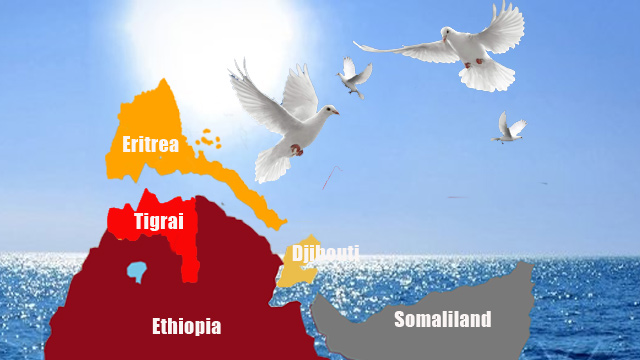Eritrea, Tigray, and Ethiopia: Where to from Here?

Passions in the current war (Eritrea and Ethiopia on one side) and Tigray on the other are running high akin to the war of the 1998 to 2000 where the majority in diaspora were settled on the notion of my country, right or wrong. When passions run this high it is rather difficult to distance oneself from the emotions of the day to think judiciously and objectively, with some dispassionate lens. This is nothing more than about who is going to wield political power between Abiy Ahmed and the EPRDF leadership. Who is paying the ultimate price? The rank-and-file soldiers on all sides. Whose life is turned upside down? Civilians, mothers, young women, and young men? Lives lost seemingly for inexplicable reasons. The polarizing nature of the current war makes it next to impossible for the warring factions to come to a roundtable to discuss power sharing mechanisms that would lead to a lasting peace.
Worse yet, the passion within the diaspora Tigrayans, Ethiopians and Eritreans are at a fever pitch; so much so entrenching in their respective positions makes it rather difficult to have a meaningful dialogue. All involved appear to be at an impasse. There appears to be a ray of hope. Whispering voices are coming to the fore to help usher a path toward “strategies for reconciliation.” A little historical context might be effusively instructive here. In 1991, at the cusp of Eritrea’s independence, Pateman made the following informed presumption.
“My major assumption, now borne out by events, is that the Dergue regime in Ethiopia would be overthrown, and that post-Mengistu Ethiopia will be characterized by decentralism and confederation. If the now deposed ruling minority [i.e., EPRDF] persists in attempts to dominate Ethiopia, I predict the continuation of the civil wars for the foreseeable future and a degeneration into the ‘warlordism’ lawlessness and violence that characterizes modern Lebanon.” (p. 43),
An opinion piece bereft of historical context leads to a decontextualized narrative. The subtext that continues to brew in Tigray today requires a very carefully thought-out consideration. Imperialism and its two attendant polities are colonization and decolonization; combined, they are the subtexts that continue to define and redefine the Horn of Africa’s past in competition with the present, inevitably, implicating the future as a sight of contention. That contention comes in a form of territorial integrity for Eritrea, and in a form of their imperialist past for Tigrayans and the Amharas.
The center of power moving between North of Ethiopia, namely, Tigray and South of Tigray, namely, the Amhara region has been the cause of raids and counterraid through the millennia. For these two Ethiopian groups who enjoyed their imperialistic hegemony for centuries are now being challenged by the most populous Ethiopian groups, the Oromos, whence Prime Minister Ahmed Abiy hails from. The center of power is distinctly about Imperialism’s past gaining political tentacle in a form of who should dictate the terms of political power, the Northern part of Ethiopia, i.e., Tigray or from the center, where the power now appears to reside. A clearer picture begins to emerge when using historical context as a lens of analysis to understand the tripartite war.
The voices of reason need to overwhelm those who are inebriated by one military force or another. These voices of reason must begin to demand for the madness to halt, and negotiating should begin in earnest. For the near and long-term options, the attendant attention should be paid to the populace of all involved parties. Is our region forever condemned to vacillate among the least desirable systems of governance? How long are we going to sacrifice our youth (speaking here of Eritreans, Tigrayans, Amharas, Oromos, Somalis, and Sudanese) in the name of wielding political power? We’ve tried Tributary State. We have used the Garrison State. What’s left now is a Failed State.Must we try them all to figure out whether they will work for our region? One hopes, the last one won’t be contemplated. Let’s now survey using the known facts.
A pretext for an attack presented itself for Ethiopian prime minister Abiy Ahmed when Tigray People’s Liberation Front (TPLF) decided to preemptively confront the northern command of Ethiopia’s National Defense Force (ENDF) on 3 November 2020. Such a preemptive attack unleashed Ethiopia’s military wrath. Many of TPLF’s senior leaders were killed and several others were captured. This monumental political miscalculation on TPLF’s part put the people of Tigray in an untenable position. The brunt of the war fell on civilian Tigrayans. Tigrayans overwhelmingly voted the TPLF to lead the province two months prior to the onset of the war. TPLF had no option but to retreat to what it knows best, to the mountains of Tigray to regroup. Eight months into the war, TPLF has gained most of its territories that were overtaken by ENDF.
Where To from here? Should TPLF attempt to declare independence, de facto, like its counterpart, Eritrean People’s Liberation Front (EPLF) did three decades earlier when these two revolutionary fronts ousted the Socialist Ethiopian government, better known as the Derg that eliminated Ethiopia’s monarchy.
The fork on the road for TPLF is presenting an existential question that will have an absolute impact on the trajectory TPLF decides to take. The people of Tigray who gave the TPLF a resounding confidence in its capacity to lead may yet become victimized once more should TPLF keep fighting. What would be accomplished by pushing forth. This is not 1991. Ethiopians have had 27 years of TPLF leadership. They have spoken clearly that their political shelf-life was over in 2018. The TPLF leadership for once should decide based on the interest of the people of Tigray, not based on the political muscle that would lead to a confrontation with Ethiopia and Eritrea on one side, TPLF on the other. The question of leadership is a tricky one for the Horn of Africa. When TPLF was at the helm of political power for 27 years it left the border question between Eritrea and Ethiopia to linger with the no-war-no-peace policy. This gave President Isaias Afewerki a chance to recover from the aftermath of the 1998-2000 border war. Eighteen years later, in 2018, the peace agreement between Abiy Ahmed of Ethiopia and Isaias Afewerki of Eritrea sidelined TPLF from the sphere of political influence it had enjoyed since 1991.
If TPLF chooses a path of war to defeat Eritrea, the corollaries of such adventures will define and redefine the political landscape of the Horn of Africa for another thirty years. If TPLF chooses a path of peace and reconciliation, however, it will have a better chance to break the cycles of war that can be traced to the 3,000-year history of Ethiopia. If there are any visionaries within these groups, a leader can emerge who would disrupt the continuous economic, social, and political disruptions and dislocations replacing it with pluralism, equity, justice, and a lasting peace that the region should try for a change. Enough with the senseless territorial squabble guarded heavily by one group or another.
Some entity from these tripartite warring factions needs to come out wiser and principled for the sake of lasting peace. Proving that one is more powerful than another is playing with the life of the people of Eritrea, Tigray, and the rest of Ethiopia. Flexing your military might on a population that does not want you to govern it is tantamount to announcing an endless war. The world is replete with examples of these kinds of wars. They are not winnable. But they are a certain path towards endless suffering.
References:
Pateman, R. (1991). Eritrea and Ethiopia: Strategies for Reconciliation in the Horn of Africa. Africa Today, 38(2), 43-54. Retrieved July 24, 2021, from http://libezp.nmsu.edu:2157/stable/4186740



Awate Forum